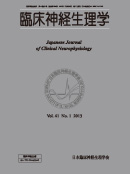Volume 52, Issue 2
Displaying 1-10 of 10 articles from this issue
- |<
- <
- 1
- >
- >|
Original Article
-
2024Volume 52Issue 2 Pages 85-94
Published: April 01, 2024
Released on J-STAGE: April 11, 2024
Download PDF (1899K) -
2024Volume 52Issue 2 Pages 95-111
Published: April 01, 2024
Released on J-STAGE: April 11, 2024
Download PDF (5034K)
Posted Review
-
2024Volume 52Issue 2 Pages 112-118
Published: April 01, 2024
Released on J-STAGE: April 11, 2024
Download PDF (2023K)
Special Features
-
2024Volume 52Issue 2 Pages 119
Published: April 01, 2024
Released on J-STAGE: April 11, 2024
Download PDF (462K) -
2024Volume 52Issue 2 Pages 120-131
Published: April 01, 2024
Released on J-STAGE: April 11, 2024
Download PDF (3108K) -
2024Volume 52Issue 2 Pages 132-141
Published: April 01, 2024
Released on J-STAGE: April 11, 2024
Download PDF (2312K) -
2024Volume 52Issue 2 Pages 142-148
Published: April 01, 2024
Released on J-STAGE: April 11, 2024
Download PDF (1329K) -
2024Volume 52Issue 2 Pages 149-157
Published: April 01, 2024
Released on J-STAGE: April 11, 2024
Download PDF (2122K)
Others
-
2024Volume 52Issue 2 Pages 158
Published: April 01, 2024
Released on J-STAGE: April 11, 2024
Download PDF (484K) -
2024Volume 52Issue 2 Pages 159
Published: April 01, 2024
Released on J-STAGE: April 11, 2024
Download PDF (519K)
- |<
- <
- 1
- >
- >|
